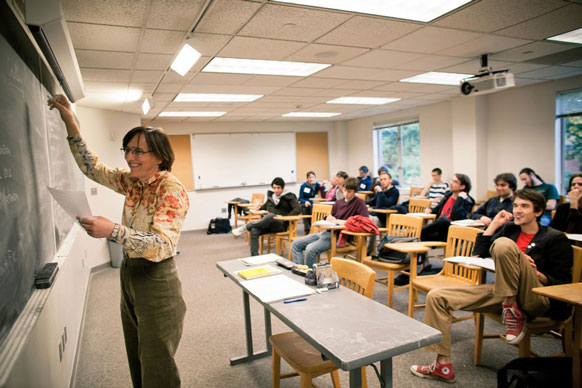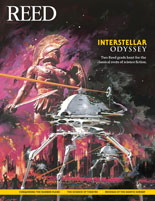
IRIS login | Reed College home Volume 94, No. 1: March 2015
Eliot Circular
Reed Declares New Majors

Prof. Irena Swanson ’87 [math 2005–]: Reed has a proud tradition of integrating computers and the humanities.
Photo by Matt D’Annunzio
The perennial sophomore’s dilemma—What should I major in?—just got harder.
In November, the faculty voted to broaden Reed’s curriculum by approving a new major in comparative literature and two new concentrations in the math department: math–computer science and math–statistics. All three tracks will be in place by fall 2015.
The math–computer science concentration may seem like the most radical addition. Are computers really compatible with Reed’s emphasis on the humanities? The answer is a resounding Yes. Reed has pioneered the use of computing in the liberal arts and sciences amid growing recognition that computer science constitutes a distinct intellectual discipline, bristling with unsolved problems, theoretical debates, and recursive paradoxes.
“Reed has a long and proud tradition of integrating computers in meaningful ways into the liberal arts,” says Prof. Irena Swanson ’87 [mathematics 2005–]. “It is now recognizing computer science as a field of study with academic methods of its own and with great interdisciplinary connections.”
Reed offers courses on algorithm design, programming languages, interactive graphics, computer systems, computability, complexity, and cryptography.
The new structure encourages students to fulfill the requirements of the math major with upper-level mathematics coursework in computer science.
In a similar vein, the math–stats concentration encourages students to pursue studies in statistics while also taking courses in applied fields such as physics, biology, psychology, or economics.
“There is a great need for Reed students outside of mathematics to be able to wrestle with data, to have sophistication in asking and answering statistical questions, and to have the computational intuitions and savvy to carry such analyses out,” says Prof. Jim Fix [mathematics 1999–]. “I think it is natural for a place like Reed to provide an option for students to engage in deep investigation of computational approaches, as a discipline in its own right, and in deep investigation of data science, also as a discipline in its own right. The math–CS and math–stats concentrations, respectively, are such options for a mathematics student.”
The comp lit major is designed for students who want to study literary questions that do not fall neatly into a particular national canon, or who want to explore relationships among literature, film, and the visual and performing arts, according to Prof. Libby Drumm [Spanish 1995–]. It will also foreground important debates about what it means to study individual cultural traditions within a “global” horizon. “I think comp lit will provide great opportunities for interdisciplinary work for our students,” says Prof. Drumm.
“A number of students have already expressed considerable enthusiasm for this new program,” agrees Prof. Jan Mieszkowski [German 1997–]. “We sense that there’s a lot of potential for exciting work.”

LATEST COMMENTS
steve-jobs-1976 I knew Steve Jobs when he was on the second floor of Quincy. (Fall...
Utnapishtim - 2 weeks ago
Prof. Mason Drukman [political science 1964–70] This is gold, pure gold. God bless, Prof. Drukman.
puredog - 1 month ago
virginia-davis-1965 Such a good friend & compatriot in the day of Satyricon...
czarchasm - 4 months ago
John Peara Baba 1990 John died of a broken heart from losing his mom and then his...
kodachrome - 7 months ago
Carol Sawyer 1962 Who wrote this obit? I'm writing something about Carol Sawyer...
MsLaurie Pepper - 8 months ago
William W. Wissman MAT 1969 ...and THREE sisters. Sabra, the oldest, Mary, the middle, and...
riclf - 10 months ago